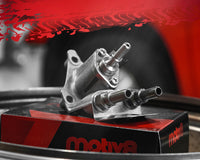A car is a self-propelled wheeled vehicle, a mechanical complex device that is driven by an internal combustion engine mounted on it. And a modern car is also a whole system of electronic equipment that controls and regulates the operation of systems and units of the car. Even, the internal combustion engine is gradually being replaced by an electric analogue. Previously, all processes in the work of the car were controlled tactilely and visually, but now came to the aid of electronic and electromechanical means, including Variable Valve Timing (VVT) Solenoid.
Variable Valve Timing (VVT) Solenoid, general information, structure and principle of operation
The engine of a modern car is quite a complex device, for its effective operation there are not enough initial settings. Some systems require automatic monitoring and constant regulation to increase performance. The gas distribution system of most modern engines is no exception, it received Variable Valve Timing (VVT). The device is compact, but functional enough. VVT Solenoid in an internal combustion engine is used to change the opening time of the intake / exhaust valves of the working mixture and exhaust gases. It is needed to increase fuel economy, combustion efficiency and reduce exhaust toxicity. The device is used as an independent electromechanical unit and in tandem with the valve height adjustment system.

For full operation of the valve, it is combined into a system complex, which consists of the following components:
- The solenoid valve itself
- VVT system filter
- Actuator - hydraulic clutch.
All components are mounted on the cylinder head, and the hydraulic clutch directly on the camshaft of the engine. The operation of the system would be impossible without auxiliary devices, they include sensors that monitor the position, speed of the crankshaft and the rotation of the camshaft.
The principle of operation of this system is based on changing the position of the camshaft relative to the crankshaft pulley, which, in turn, leads to a change in the time of opening the inlet / outlet valves - overtaking or delayed. For example, if RPMs are high at idle, then the system starts a complex interaction. The crankshaft speed sensor signals the excess of the solenoid valve, which works accordingly and causes the hydraulic clutch to perform a slight rotation of the camshaft, which reduces engine speed as a whole, as well as fuel economy, reduced emissions.
The solenoid valve itself is a complex device, it consists of such replacement parts and components as: plunger, connector, spring, spool, housing, electrical winding, hole for supply, supply and drainage of oil. The valve works simply - the electronic control unit of the engine generates the corresponding signal which is given to a winding of the electromagnet, it, having received an impulse, forces the spool to move through the plunger. This action allows you to pass the oil in different directions, and it already controls the operation of the clutch, which regulates the position of the camshaft. As you can see, schematically everything is quite simple.
Car malfunctions that occur when the valve is faulty
Variable Valve Timing regulates and controls the operation of the engine's timing system, the serviceability of which directly affects the operation of the entire engine, its performance, efficiency and compliance with environmental requirements. After the failure of one of the components of this complex, the operation of the internal combustion engine, of course, will not stop, but it will be inefficient and will be characterized by negative trends in the overall picture of the car itself. If the RPMs drop when entering the gear or when you press the gas for a short time, the engine stalls can be said to be a malfunction of the timing system, and this is caused by problems with the timing system controlled by the solenoid valve. The circle is closed and the reason must be found there.
Solenoid valve is not a panacea for all potential problems in the engine's timing system, but it guarantees its correct operation. Electronic sensors are quite sensitive to overestimated / underestimated crankshaft speeds, so the solenoid valve will be able to respond quickly to problems in the system. In general, if the engine does not start, maintains, unnecessarily, high revs or stalls for no apparent reason, it is necessary without delay to carry out maintenance of engine systems, including Variable Valve Timing, sometimes it will help to replace or clean the system filters. But it would be better to entrust the equipment to specialists in this field.





